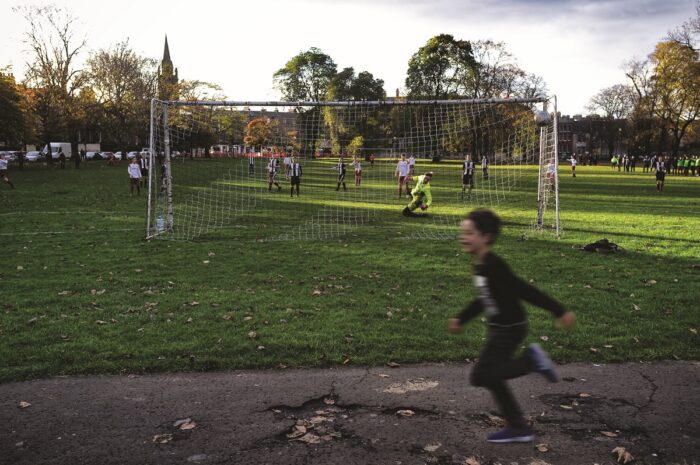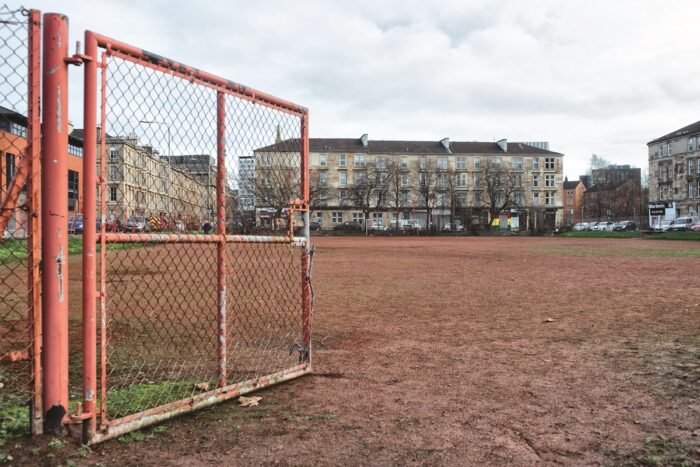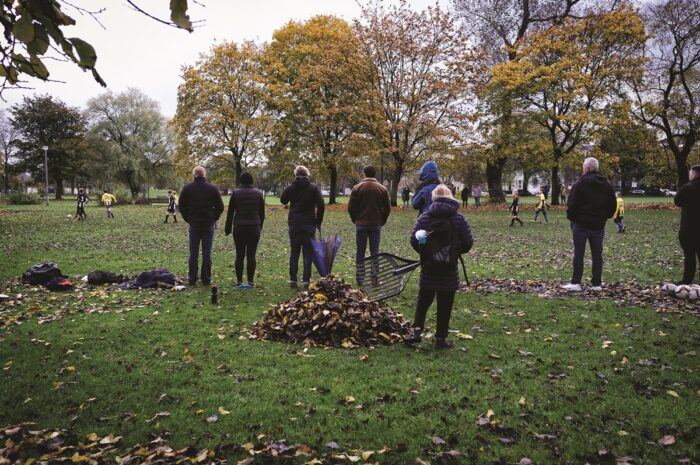
Scotland’s later developers have a mountain to climb to succeed in a system that decides their potential in their very earliest years.
On May 15, 2002, Real Madrid beat Bayern Leverkusen in the Champions League final at Hampden Park. In Glasgow at the time were some of the highest paid players in world football. One of them was not playing in the final. He was Stefan Kloss and he played for Rangers.
While Rangers were in a league of their own when it came to bankrolling success, many others were not much better at managing their finances. In the same season that UEFA rolled into town, a PwC report declared five out of our 12 top-flight clubs to be technically insolvent. Only Celtic were deemed to be operating within the 60% wages-to-turnover benchmark.
Astonishingly, in little over a decade, the combined wage bill in Scotland’s top flight had risen from around £10.5m to close to £110m. The catalyst for this was the Bosman ruling of 1995 and the subsequent abolishment of the 3+2 rule that followed. This meant that out-of-contract players could now move freely within the European Union, while clubs no longer had to field only three foreign players in European competitions.
Youth players were now swimming against a relentless tide of imported players, and many were swept away in this strong and fast-moving current. Clubs no longer had to wait for young homegrown players to be ready. Instead, they could bring in those deemed to be the finished article from further afield. The floodgates had opened – it changed the economics of the game and with it, our century-old tradition of producing players of the highest ability.
The effect of the Bosman ruling would be felt across Europe. By 1999, it was clear that trouble was looming and that something wasn’t quite right. Clubs, national associations and UEFA were growing concerned with the state of youth development and what was perceived as a lack of investment in youth football. This would lead to the new UEFA club licensing scheme that clubs now need if they are to play in European football.
Significantly, this would have a profound effect on the way clubs would engage with and select young people. It set in place a structure that we still follow to this day.
Article 20 states that the licence applicant must have the following youth teams within its legal entity: at least four youth teams within the age range of 10 to 21 and at least one Under-10 team or organised football activities for Under-10s. This signalled a fundamental shift in the dynamics of youth football. Selection into the elite system would now begin around eight or nine years old (sometimes earlier) in preparation for the official academy programme to start.
At a very early age we now have a “path of separation” in the footballing lives of young people. Those scouted into an elite academy will grow up in one system (System 1) and everyone else will grow up in another (System 2). The effects of these new dynamics would ripple through the game and into the home lives of young players and beyond. Most notably it set the wheels in motion that would begin to drive the game away from its working-class roots.
Now, and in the knowledge that the terms of engagement had changed, we were about to see a significant takeover of the game by the more affluent classes. To be good enough to enter System 1 at such a young age was going to take intensive and early preparation.
The best of five: Football fates decided by the time they start school
It works like this. If you are going to “be good enough to get scouted” at eight or nine you’ll have to have been good enough to play for one of the better local teams in your area from the age of six or seven; to be good enough to be in one of the better teams at six or seven you’ll probably have to have been playing football for at least a couple of years before this.
For some, this would now require the “concentrated cultivation” of the young person, often leading to their lives being dominated by activities organised and controlled by mothers and fathers. Dutch psychologist Jan Derksen coined the phrase the achterbankgeneratie (backseat generation) to characterise the generation of children who grow up in the back seat of their parents’ car as they’re driven to and from extracurricular activity.
In contrast to this, working-class and poorer families traditionally have a more organic approach to a child’s development. A less regimented upbringing would now work against those trying to break into professional football. The entry criteria have become stacked in favour of those who value the “early start” and have the time and resources to direct at it.
Football in the twentieth century didn’t work like this. It was the game of the “people” because of its accessibility and low-cost entry point. For many Scots, it was a way out of social and cultural hardship. It was the same the world over. Poverty and hardship created the game’s greats, and it did so in volume. Street smarts and cunning when mixed with high quantities of informal engagement are a potent mix for the creation of top players. Here we see the first major shift in the game since the previous century. With no requirement to select so young, clubs could “wait” on those who otherwise would not today be selected into an elite system at nine years old.

For the love of the game: How many potential stars might Scotland lose in its rush to decide who will make the grade?
In the 1930s, Alex James was a bona fide superstar of the game at Arsenal – today, at the London club, he is described as the Dennis Bergkamp of his day. James was still playing Junior football at 20. In the same era, Hughie Gallacher would establish himself as one of the greatest centre-forwards of all time at Newcastle United. As youngsters, both Gallacher and James were rejected by local team Bellshill Athletic for being “far too small”.
Later in the century, Stevie Chalmers was still playing Junior football at 23 – he would go on to score the winning goal in the European Cup Final in 1967 and is Celtic’s fifth highest goalscorer, with 236 goals. Toward the latter part of the century, Stevie Archibald was playing for Fernhill Athletic before signing for Clyde two months before his 18th birthday. He would soon go to Aberdeen, then Tottenham Hotspur, before filling Maradona’s number 10 shirt at Barcelona.
This article is from Issue 31 of Nutmeg – pre-order your copy now
These players, and hundreds more, would likely be lost to the game if they had to come through today’s system – we wouldn’t know their names and the Scottish Football Hall of Fame would be unrecognisable.
Among other factors, the “late entry” system of the twentieth century allowed slower maturing and/or less physical boys to catch up and overtake the early maturing more physical ones. As underdogs they often had to develop superior technical skills, as well as enhanced non-physical skills. When they eventually caught up physically, they had more of what it took to succeed.
Today’s early-entry system has potentially crowded these boys out. You may argue that the cream will always rise to the top. Well, you can’t rise to the top if you’re not in the bottle in the first place. That’s what happens with a path of separation. With each passing year, from the initial intake onwards, the likelihood of entering System 1 becomes lower and lower. Those selected early experience a multiplier effect where extra training, better coaching and more support interact to accelerate development by comparison with their non-selected peers. The “rich get richer and the poor get poorer”.

Scotland could be closing the door on the communities who have always provided our best players.
For most kids not in System 1 their dream of being a professional player is all but over before it’s even started. This despite football being a game where players don’t peak until their mid-twenties.
Back to the 21st century and it wouldn’t take long to realise that things were still not working out when it came to youth football. It was now time to take matters into our own hands. In May 2009, former first minister of Scotland Henry McLeish was asked by the SFA to undertake a Review of Scottish Football. In 2010, two reports were published whose recommendations would be overwhelmingly implemented.
To guide the implementation of the review, the SFA published its new performance strategy, entitled Scotland United: A 2020 Vision. The opening statement of this declared: “January 12, 2011. It is a date that should be remembered as the day the Scottish FA took its first steps towards the most radical overhaul in its 138-year history.”
A new golden age?
When it came to improving the standard of youth football, and therefore the standard of the game, two major themes were front and centre in the review – our skill level and our treatment of talent. We were warned that the level of skill in Scottish players was well below that of other comparable countries and leagues. In order to address this and return to “the golden age” of Scottish football, the review calls for a move towards a new age of aspiration and ambition, an age of unashamed “pursuit of excellence”, where we rethink the way that we not only identify and manage talent but shift to a new mindset in how we “value” it. In fact, so valuable is it that we’re asked to afford it a “prized and privileged” position in Scotland and treat it accordingly.
On the face of it, talent and skill development seem to be logical areas to focus on if you want to improve a product that seems to be impoverished of both. However, this is where things become complicated.
To begin with “talent” is a shaky concept, particularly when applied to children. First, everyone thinks they know a player when they see one, that is, quite literally everyone. The problem with selection at a young age is that it’s not difficult to turn up at your local park and spot the best children aged eight, nine or 10. For several reasons they are easy to spot at this age. So-called talented youngsters are what Rasmus Ankersen, author of The Gold Mine Effect, describes as the “screaming talent”. The talent that literally can’t be missed. However, it’s a lot more difficult to spot, or have confidence in selecting, what Ankersen describes as the “whispering talent”, those who don’t quite stand out, those who tick fewer boxes than the screaming talent.

Everyone can spot the “screaming talent”. But Scottish football’s Hall of Fame is full of players whose true talent only emerged later in their development.
Why then do we make so many miscalculations and get it wrong so often when the best young players are so glaringly obvious? According to the ground-breaking psychology professors Daniel Kahneman and Amos Tversky, these errors repeat themselves whenever people are asked to evaluate and make a judgement of anything with random components to it – and there’s nothing more random than a child.
It’s outside the scope of this article to list all the randomness that is playing out in children, but here’s a key one to think about for now. Children mature at different rates and the difference could be anything up to six years. This means you could be watching a nine-year-old playing against a 15-year-old when you’re assessing two 12-year-olds.
A pioneer in researching this effect is Professor Sean Cumming from Orkney. Cumming, alongside his colleagues, has found that early maturers perform more high-intensity actions, more frequent high-speed running distances and achieve peak speeds faster during matches than less mature opponents of the same age. When it comes to ticking boxes, these are useful attributes. The fact is, bigger, stronger, faster children have a better chance of being selected for System 1 than smaller, weaker, slower ones.
So poor is the “known” efficacy of talent identification that one of the world’s most eminent researchers in the field, Professor Joe Baker from York University in Canada, encourages those in talent identification roles to consider the following question: “What would you do for talent selection if you assumed you were terrible at making these decisions instead of assuming you were good?” because “… the evidence suggests you’re terrible at making these decisions”. The last word on the concept of talent is this. It only becomes a less shaky concept if you close the gap between when you select the talent and when you put it to use – the quicker the better.
Smells like teen spirit
In the previous century, John Collins was offered his first professional deal after a trial for Hibernian at 16, made his first-team debut at 17 and went on to play nearly 200 games for them before moving to Celtic and then Monaco. Archibald has already been mentioned: Fernhill Athletic at 17 and Barcelona within seven years of leaving Clyde. At 18, Brian McClair was invited to train with Motherwell on a Monday and was put in the first team on the Tuesday; within two years he would sign for Celtic before going on to play more than 350 times for Manchester United.
Where are the players of this quality today? The likelihood is they have fallen through the cracks in the system created by the rationale of selecting “talented” nine-year-olds into elite academies. If one shaky concept wasn’t enough, we would soon bolt on a second even more dubious one for good measure. With a new mindset towards talent ready to be ushered in, we now needed to focus on the intensity of attention and provision it needed in order to turn it into players capable of elevating Scotland’s fortunes on the pitch. This intensity of attention and provision was mapped out in the strategy as follows: “We need to establish the 10,000 hours standard for top class skill development… The 10,000 hours issue remains an international benchmark for top-class skill development. There is need for deliberate practice and play over a 10-year period (three hours a day). This is associated with expert international levels of performance.”
I would imagine that by now everyone is familiar with the so-called 10,000 hours standard, or its more popular label, the 10,000-hour “rule”. To date, in the 21st century, no other idea, theme or concept has made a bigger impact on talent development than this one. Quite simply the “rule” is said to be this: if you want to become an expert performer, you need to practise for three hours per day, five days a week, for 10 years.
In the years leading up to the review, the “rule” had been seized upon in “pop-psych” literature where it quickly found mass appeal. Bestselling books such as Geoff Colvin’s Talent is Overrated (2008), Malcolm Gladwell’s Outliers (2009) and Daniel Coyle’s The Talent Code (2009) gave it a mainstream audience. The concept dates to 1993 and a Swedish professor of psychology by the name of K. Anders Ericsson. Along with his colleagues, Ericsson compared the practice habits of expert musicians attending the Music Academy of West Berlin with those of non-expert musicians and concluded that a key factor differentiating the groups lay in the greater number of hours the experts spent practising compared with the non-experts. The hours accumulated by the expert musicians showed that it took three hours per day of “deliberate practice” for 10 years to reach the highest level of performance.
The negative effect of this new information was twofold. First, there was a sudden rush to have children begin to accumulate the required hours, often the younger the better. In theory, the quicker you begin deliberate practice, the more likely it is that you’ll gain an advantage over someone the same age who starts later. Secondly, if you have two 10-year-olds and child A starts focused and consistent practice at five years old, and child B starts at nine, who do you think is going to be selected by a talent scout if they’re both on the same pitch during an U10 match?
Age of first engagement is just another random component that further muddies the murky waters of talent identification. Last year, the Sports Medicine journal published a study showing that while high-performing juniors were part of talent development programmes earlier than lesser-performing juniors, higher-performing seniors joined a talent development programme later than lesser-performing seniors.
This effect can be seen in the Scotland team that reached the semi-final of the UEFA European Under 17 Championships in 2014. To date, not one of them has been capped at senior international level. This is despite the group collectively making 350 appearances for Scotland at the various youth-level age groups.
The mechanisms behind this effect are for another time. For now, let’s move on to look a little more at our talent and 10,000-hour national strategy. With the case now made, it was time to go about putting in place a system capable of supporting the theory. What we now needed was a platform capable of providing the “talented” few with the high quantities of practice needed to reach expert levels of performance.
Centres of excellence − and exclusion?
To deliver this the review recommended that: “The Scottish FA should establish Schools of Football/Football Academies based on developing centres of excellence – at least 20 comprehensive school-based models which are integrated into the school curriculum.” The report had highlighted that in every major European football set-up, education and football are intertwined. Barcelona was identified as having the “best youth system in the world” and their approach was that of combining football and education as this afforded the players the opportunity to spend more time with the ball at their feet.
Not surprisingly, La Masia, the club’s famed youth academy, had become the “champions model” of the day. This assumes that the most successful team of the day has hit on a winning formula. Around the same time as the report was being developed, Barcelona was dominating world football. In 2008/09 they won the Champions League, La Liga and the Copa del Rey. The team of 2010 were perhaps the greatest club team ever and that team included the likes of Puyol, Messi, Xavi, Busquets and Iniesta – and they were all graduates of La Masia. As such, it made sense for others to adopt a similar approach.
In 2012, the SFA launched their new performance schools programme and the Dutchman Mark Wotte was appointed to the role of SFA performance director. Today, the schools operate in seven key regions:
- Hazlehead Academy in Aberdeen
- St John’s RC High School in Dundee
- Broughton High School in Edinburgh
- Graeme High School in Falkirk
- Holyrood Secondary School in Glasgow
- Grange Academy in Kilmarnock
- Braidhurst High School in Motherwell
School attendees receive an extra 800 hours of coaching, and this is delivered during school hours. Programmes are supported by elite coaches, national team coaches, sport scientists and other specialist experts. The extent to which performance schools have helped to elevate the “gold dust” quality of Scotland’s elite to new levels is hard to tell.
When Wotte was appointed, he told the media: “When we’re in 2020 and we have four or five top players with a performance school history, we’ll have done a great job. That’s the goal. In 2020 come and chat to me again about it.”
When Steve Clarke named his 26-man squad for Euro 2020, Nathan Patterson, who was breaking through at Rangers before his move to Everton, and Billy Gilmour, who was with Chelsea at the time, were both selected – and notably they were also performance school graduates. The vision, for some, had been realised.
However, the other 24 members of the squad all had to go to school somewhere, in the same way as Jimmy Johnstone, Kenny Dalglish, Jim Baxter and all the other greats did. Only time will tell if performance schools are the production line that produces high quantities of world-class players, capable of enhancing our game and playing for the best teams in the best leagues in the world.
For now, it seems clear that if the great players who would become legends of the game in the twentieth century had been born 30 years ago, there’s a real danger you may never have heard of them. Fortunately for them, the system of the time allowed their greatness to flower and be shared. These players continue to give us the belief that the latent potential for greatness still lies somewhere in our DNA.
If this is true, there are future world-class players waiting on us to sort “The System” out, to allow them to share their greatness in the same way – and that’s the task in front of us: to develop a system that allows this to happen before this generation and subsequent ones are also lost to the game.
Graeme McDowall is author of The System: What We Can Learn When Science and Reason Collide with Scottish Football (Pitch Publishing)


